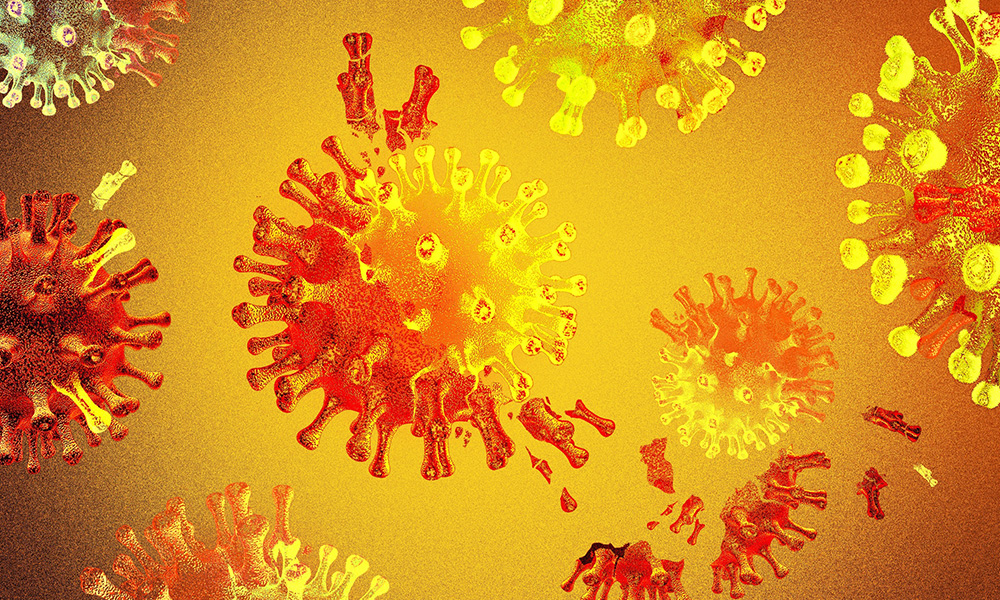
今年早些時候,人們對奧密克戎“超強變異株”的擔憂成真,,并且變得日益擔憂,。
塞浦路斯的一名研究人員發(fā)現(xiàn)了一種新冠變異株,同時具有德爾塔變異株的致命性和奧密克戎變異株的高傳播性與超強免疫逃脫能力特征。這種新變異株名為“德爾塔克戎”,,是結合兩種變異株的“弗蘭肯病毒”,。
“德爾塔克戎”變異株并未廣泛傳播,很快就消失了,。后來出現(xiàn)的第二種德爾塔-奧密克戎混合變異株也消失了。
但它所引發(fā)的這種現(xiàn)象,,可能在今年秋季產生影響,。科學家們預測,,由于多個奧密克戎變異株相互之間或者與之前的病毒株變得越來越相似,,從今年10月到明年1月,將會出現(xiàn)一波嚴重的疫情,。
它們可能是免疫逃脫能力和傳播力最強的新冠病毒變異株,。這種相似性可能是好事,也可能是壞事:有可能讓變異株變得更容易對付,,也可能更難控制,。
約翰斯霍普金斯大學醫(yī)學系(Johns Hopkins Department of Medicine)數(shù)據(jù)完整性與分析醫(yī)學副主任斯圖爾特·雷伊告訴《財富》雜志,隨著奧密克戎變異株的進化,,它“正在重新找到阿爾法,、伽馬和德爾塔等變異株以前用過的辦法”,“并使新變異株出現(xiàn)一些新的變化”,。
他說道:“這是進化過程中一個迷人的部分,。就好像我們用碎步縫制一床新被子?!?/p>
不同的路徑,,相同的目標
位于阿肯色州瓊斯博羅的紐約理工學院(New York Institute of Technology)研究助理院長和副教授拉吉·拉吉納拉亞南博士對《財富》雜志表示,雖然秋季新冠疫情可能源于多種變異株,,數(shù)量多達5種或以上,,但這些變異株之間的差異微乎其微。
變異株在趨同進化這種平行進化過程中,,正在發(fā)生相同的突變,,這些突變令人擔憂。拉吉納拉亞南表示,,換言之,,同一種病毒的多個變異株可能產生類似的突變,例如有些突變可幫助病毒逃脫免疫,,變得更容易傳播,。
例如,明尼蘇達大學(University of Minnesota)傳染病研究與政策中心(Center for Infectious Disease Research and Policy,CIDRAP)主任邁克爾·奧斯特霍姆博士對《財富》雜志表示,,目前全球主要病毒株BA.5疫情在許多地方已經(jīng)開始消退,,但其衍生病毒株正在出現(xiàn)增強免疫逃脫能力的變異。
奧斯特霍姆提到變異株對免疫系統(tǒng)和疫苗與治療藥物等支持免疫系統(tǒng)的工具的逃脫能力越來越強,,他表示:“我們從未見過這類免疫逃脫,。”
與此同時,,新冠病毒株還在通過重組過程出現(xiàn)變異,,德爾塔克戎變異株就是這種進化過程的結果。在重組進化過程中,,兩種變異株融合為一種變異株,。例如,拉吉納拉亞南表示,,新出現(xiàn)的XBB變異株合并了兩種不同奧密克戎變異株,,是至今為止我們見過的免疫逃脫能力最強的新冠病毒株。
他表示,,德爾塔克戎變異株最早只在一間實驗室中被發(fā)現(xiàn),,這意味著它可能是實驗室污染的產物,但在孟加拉國,、以色列,、新加坡、德國和丹麥等世界各地都已經(jīng)發(fā)現(xiàn)了XBB,。
今年秋天各種奧密克戎變異株的混合匹配,,最終是否會誕生某個“超級病毒”?
專家表示,,這一點很難預測,。但奧密克戎可能接近于達到“局部適應性高峰”,這意味著這種仍在快速進化的病毒株,,可能很快無法傳播,,或者不再具有比之前的病毒更強的免疫逃脫能力。
關于奧密克戎,,雷伊表示:“我很想知道它是否已經(jīng)別無其他選擇,。雖然這并不意味著奧密克戎的傳播已經(jīng)達到了最高峰,但是這可能會限制它的傳播,?!?/p>
今年冬季的新敵人是誰?
如果說奧密克戎的傳播確實已經(jīng)達到了最高峰,,這可能為一種全新變異株的出現(xiàn)掃清道路,,例如2021年夏季美國出現(xiàn)的德爾塔變異株,,以及幾個月后的奧密克戎變異株。
雷伊提到了在阿爾法,、貝塔,、伽馬、德爾塔和奧密克戎之后再出現(xiàn)一種強大變異株的可能性,。他表示:“可能新變異株派正在某處潛伏,,它可能具有全新的特征。如果病毒失去了有利變化的空間,,就可能會出現(xiàn)一種新變異株,,改變這一現(xiàn)狀?!?/p>
他又表示:“已經(jīng)有很長時間沒有出現(xiàn)出人意料的強大新變異株。但我可以合理推斷,,今年冬天就會出現(xiàn)這樣一種變異株,。只是沒有人能夠對此進行預測?!?/p>
奧斯特霍姆也認為,,全世界“可能會出現(xiàn)派或西格瑪變異株”。
他表示:“沒有人知道,,這就是我們現(xiàn)在所面臨的挑戰(zhàn),。我們只能非常謙卑地說,我們不知道第二只鞋子會在什么時候落下,?!?/p>
他還表示:“我們也很有可能開始看到所謂的‘軟著陸’,”即病例人數(shù)逐步減少,。
然而,,奧斯特霍姆并沒有發(fā)現(xiàn)任何證據(jù),能證明新冠病毒正在像某些白宮官員最近所說的那樣,,轉變成一種類似于流感的季節(jié)性病毒,,只要每年一劑疫苗就足以防止感染。
他說這種病毒就像是一場“三幕戲”,。
他說道:“問題是,,我認為我們才演到第二幕?!保ㄘ敻恢形木W(wǎng))
譯者:劉進龍
審校:汪皓
今年早些時候,,人們對奧密克戎“超強變異株”的擔憂成真,并且變得日益擔憂,。
塞浦路斯的一名研究人員發(fā)現(xiàn)了一種新冠變異株,,同時具有德爾塔變異株的致命性和奧密克戎變異株的高傳播性與超強免疫逃脫能力特征,。這種新變異株名為“德爾塔克戎”,是結合兩種變異株的“弗蘭肯病毒”,。
“德爾塔克戎”變異株并未廣泛傳播,,很快就消失了。后來出現(xiàn)的第二種德爾塔-奧密克戎混合變異株也消失了,。
但它所引發(fā)的這種現(xiàn)象,,可能在今年秋季產生影響??茖W家們預測,,由于多個奧密克戎變異株相互之間或者與之前的病毒株變得越來越相似,從今年10月到明年1月,,將會出現(xiàn)一波嚴重的疫情,。
它們可能是免疫逃脫能力和傳播力最強的新冠病毒變異株。這種相似性可能是好事,,也可能是壞事:有可能讓變異株變得更容易對付,,也可能更難控制。
約翰斯霍普金斯大學醫(yī)學系(Johns Hopkins Department of Medicine)數(shù)據(jù)完整性與分析醫(yī)學副主任斯圖爾特·雷伊告訴《財富》雜志,,隨著奧密克戎變異株的進化,,它“正在重新找到阿爾法、伽馬和德爾塔等變異株以前用過的辦法”,,“并使新變異株出現(xiàn)一些新的變化”,。
他說道:“這是進化過程中一個迷人的部分。就好像我們用碎步縫制一床新被子,?!?/p>
不同的路徑,相同的目標
位于阿肯色州瓊斯博羅的紐約理工學院(New York Institute of Technology)研究助理院長和副教授拉吉·拉吉納拉亞南博士對《財富》雜志表示,,雖然秋季新冠疫情可能源于多種變異株,,數(shù)量多達5種或以上,但這些變異株之間的差異微乎其微,。
變異株在趨同進化這種平行進化過程中,,正在發(fā)生相同的突變,這些突變令人擔憂,。拉吉納拉亞南表示,,換言之,同一種病毒的多個變異株可能產生類似的突變,,例如有些突變可幫助病毒逃脫免疫,,變得更容易傳播。
例如,,明尼蘇達大學(University of Minnesota)傳染病研究與政策中心(Center for Infectious Disease Research and Policy,,CIDRAP)主任邁克爾·奧斯特霍姆博士對《財富》雜志表示,,目前全球主要病毒株BA.5疫情在許多地方已經(jīng)開始消退,但其衍生病毒株正在出現(xiàn)增強免疫逃脫能力的變異,。
奧斯特霍姆提到變異株對免疫系統(tǒng)和疫苗與治療藥物等支持免疫系統(tǒng)的工具的逃脫能力越來越強,,他表示:“我們從未見過這類免疫逃脫?!?/p>
與此同時,,新冠病毒株還在通過重組過程出現(xiàn)變異,德爾塔克戎變異株就是這種進化過程的結果,。在重組進化過程中,,兩種變異株融合為一種變異株。例如,,拉吉納拉亞南表示,,新出現(xiàn)的XBB變異株合并了兩種不同奧密克戎變異株,是至今為止我們見過的免疫逃脫能力最強的新冠病毒株,。
他表示,,德爾塔克戎變異株最早只在一間實驗室中被發(fā)現(xiàn),這意味著它可能是實驗室污染的產物,,但在孟加拉國、以色列,、新加坡,、德國和丹麥等世界各地都已經(jīng)發(fā)現(xiàn)了XBB。
今年秋天各種奧密克戎變異株的混合匹配,,最終是否會誕生某個“超級病毒”,?
專家表示,這一點很難預測,。但奧密克戎可能接近于達到“局部適應性高峰”,,這意味著這種仍在快速進化的病毒株,可能很快無法傳播,,或者不再具有比之前的病毒更強的免疫逃脫能力,。
關于奧密克戎,雷伊表示:“我很想知道它是否已經(jīng)別無其他選擇,。雖然這并不意味著奧密克戎的傳播已經(jīng)達到了最高峰,,但是這可能會限制它的傳播?!?/p>
今年冬季的新敵人是誰,?
如果說奧密克戎的傳播確實已經(jīng)達到了最高峰,這可能為一種全新變異株的出現(xiàn)掃清道路,,例如2021年夏季美國出現(xiàn)的德爾塔變異株,,以及幾個月后的奧密克戎變異株,。
雷伊提到了在阿爾法、貝塔,、伽馬,、德爾塔和奧密克戎之后再出現(xiàn)一種強大變異株的可能性。他表示:“可能新變異株派正在某處潛伏,,它可能具有全新的特征,。如果病毒失去了有利變化的空間,就可能會出現(xiàn)一種新變異株,,改變這一現(xiàn)狀,。”
他又表示:“已經(jīng)有很長時間沒有出現(xiàn)出人意料的強大新變異株,。但我可以合理推斷,,今年冬天就會出現(xiàn)這樣一種變異株。只是沒有人能夠對此進行預測,?!?/p>
奧斯特霍姆也認為,全世界“可能會出現(xiàn)派或西格瑪變異株”,。
他表示:“沒有人知道,,這就是我們現(xiàn)在所面臨的挑戰(zhàn)。我們只能非常謙卑地說,,我們不知道第二只鞋子會在什么時候落下,。”
他還表示:“我們也很有可能開始看到所謂的‘軟著陸’,,”即病例人數(shù)逐步減少,。
然而,奧斯特霍姆并沒有發(fā)現(xiàn)任何證據(jù),,能證明新冠病毒正在像某些白宮官員最近所說的那樣,,轉變成一種類似于流感的季節(jié)性病毒,只要每年一劑疫苗就足以防止感染,。
他說這種病毒就像是一場“三幕戲”,。
他說道:“問題是,我認為我們才演到第二幕,?!保ㄘ敻恢形木W(wǎng))
譯者:劉進龍
審校:汪皓
Earlier this year, fears of a new “super strain” of Omicron were real—and rising.
A researcher in Cyprus identified a COVID-19 variant that had features of both the deadly Delta and the highly transmissible, immune-evasive Omicron variants. “Deltacron,” as the new variant became known, was a bit of a “frankenvirus” that combined the two strains.
Deltacron failed to take off, and it soon disappeared. A second Delta-Omicron hybrid later arose then also subsided.
But the phenomenon that caused it is likely to come into play this fall. Scientists expect a sizable wave of COVID cases October through January, fueled by multiple Omicron spinoffs that look increasingly alike—both to each other and to older versions of the scourge.
They’re expected to be the most immune-evasive, transmissible versions of the virus yet. Their similarity could be a blessing or curse: It could make them easier to fight—or harder to control.
As Omicron evolves, it’s “rediscovering solutions that have been used before” in variants like Alpha, Gamma, and Delta “while bringing some new things along with its lineage,” Dr. Stuart Ray, vice chair of medicine for data integrity and analytics at Johns Hopkins Department of Medicine, told Fortune.
“It’s a fascinating part of evolution,” he said. “We see the same scraps of cloth being used to make a new quilt.”
Different paths, same goal
While a fall wave of COVID may be fueled by multiple variants—as many as five or more—the differences between them could be minor, Dr. Raj Rajnarayanan, assistant dean of research and associate professor at the New York Institute of Technology campus in Jonesboro, Ark., told Fortune.
In a form of parallel evolution called convergent evolution, variants are collecting identical sets of concerning mutations. In other words, multiple strains of the same virus are picking up similar mutations, like ones that will help them evade immunity and make it easier for the virus to spread, according to Rajnarayanan.
One example: The wave of globally dominant BA.5 is beginning to recede in many locations—but its spin-offs are picking up mutations that promote immune evasion, Dr. Michael Osterholm, director of the University of Minnesota’s Center for Infectious Disease Research and Policy (CIDRAP), told Fortune.
“We’ve not seen this type of immune evasion before,” he said, speaking of the variants’ increasing ability to dodge the immune system and tools that bolster it, like vaccines and treatments.
Meanwhile, COVID strains are also mutating through a process called recombination—the same strategy the so-called Deltacron strain used. In this scenario, two variants meld into one. Case in point: new variant XBB, a merger of two different Omicron spawns that is the most immune-evasive COVID strain seen yet, according to Rajnarayanan.
Unlike the initial Deltacron—which was only identified in a single lab, signaling that it may have been a product of lab contamination—XBB is being found worldwide in places like Bangladesh, Israel, Singapore, Germany, and Denmark, he said.
With all the mixing and matching of Omicron spawn occurring this fall, will the resulting muddled mess constitute some kind of “super virus”?
It’s impossible to know, experts say. But Omicron may be close to reaching a “l(fā)ocal fitness peak,” meaning the variant—while still evolving quickly—might soon be unable to spread or evade human immune systems any better than their predecessors.
“I do wonder if it’s running out of options,” Ray said of Omicron. “It doesn’t mean it’s reached the peak of spread, but it may put some bounds on it.”
A new foe this winter?
If Omicron is indeed peaking in terms of performance, it could pave the way for the entrance of a completely new variant, like Delta, which arrived in the U.S. in the summer of 2021, and Omicron, which hit several months later.
“Somewhere there might be a Pi lurking that has a new set of solutions,” Ray said, referring to the possibility of another major variant along the lines of Alpha, Beta, Gamma, Delta, and Omicron. “If the virus runs out of space for advantageous changes, a new variant might emerge that changes the calculus for all of us.”
He continued: “It’s been a while since we’ve seen a big new variant come out of left field. But I think it’s reasonable to believe it’s going to happen this winter. It’s just nothing anyone can predict.”
Osterholm agrees that the world “could be in a situation where Pi or Sigma show up.”
“None of us know—that’s the challenge right now,” he said. “We just have to be very humble and say we don’t know what the next shoe to drop is.”
It’s also possible that “we begin to see what I call a ‘soft landing,’” a gradual lowering in the number of cases, he added.
Osterholm sees no evidence, however, that COVID is turning into a seasonal virus like the flu and that one vaccine a year will suffice, like some White House officials recently suggested.
The virus, he says, is a “three act play.”
“I think we’re only in the second act,” he said. “That’s the problem.”






